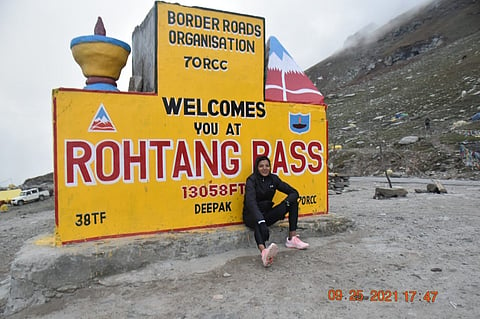
- Destinations
- Experiences
- Stay
- What's new
- Celebrating People
- Responsible Tourism
- CampaignsCampaigns
- Subscribe
- Buy Now

The Manali-Leh highway, a heaven for thrill seekers who descend on its circuitous roads every summer, is arguably one of the toughest roads to conquer, going through some of the world&rsquos highest mountain passes. On September 25, at an altitude of 2,000m on the famed highway, Sufiya set out to push her physical limits, on foot. The ultramarathon runner completed a gruelling journey of 430km, starting from Manali and ending in Leh, and became the first female runner to achieve this feat.
Is she exhausted &ldquoI am ecstatic and tired in equal measure. I completed the run in 6 days, 12 hours and 10 minutes. This was by far the most gruelling run of my life but I was committed to attempting this world record,&rdquo says Sufiya, as she awaits Guinness World Record confirmation.
When she says gruelling, she doesn&rsquot say it lightly. The Delhi-based runner had earlier this year completed a run of over 6,000 kilometres across the Golden Quadrilateral in India, in a record time of 110 days and 23 hours. She had also undertaken the mammoth task of running the K2K - a 4,000 kilometres run from Kashmir to Kanyakumari in 87 days. No stranger to hard work, Sufiya says Leh tested her unlike any other terrain. The preparation for this gigantic task, hence, started soon after Sufiya returned from the arduous GQ run, and had been six months in the making. They had to take it up before the roads were closed due to the onset of winters.
&ldquoI had decided that acclimating myself to the area was of prime importance. So I trained on the road between Manali and Leh for 20 days and understood the needs of the undertaking. Apart from physical training, I focussed on strengthening my lung power I practised yoga and pranayam as well but the main area of focus was always mental agility,&rdquo she says, adding that the running is a &ldquo90% mental and 10% physical exercise.&rdquo
The 35-year-old had started running in 2017, after a tiring job with the aviation industry left her with no time for the gym. &ldquoI used to feel lethargic all the time, since I worked night shifts. My partner Vikas, who is a cyclist himself, motivated me to start running, and that is how my tryst with long-distance running happened,&rdquo she describes. In spite of the financial challenges, she quit her job to pursue running full-time.
The Himalayan Ultra run expedition, Sufiya says, was exhausting but allowed her to really enjoy the beauty of Ladakh. &ldquoSo many people fly down to Manali, but it is the journey that matters. While I was running, I could enjoy every sound, every stream, every sunset right in front of me, without any urgency. No wonder running is the best form of travelling,&rdquo she opines.
She made her way from Rohtang, traversing idyllic places like Baralacha La, Lachulung La, Sarchu and the famous Gata Loops, with the altitude going up to 5,400m with total 9,000m elevation gain throughout the expedition.
For the duration of her run, she had a car that would move along with her. And Vikas, accompanied by her coach, would inspire her to keep pushing against all odds. During the run, Sufiya kept a steady speed and ran continuously for hours, stopping only to catch a wink of sleep.
On the first day, she covered Rohtang, running a distance of 65km in a span of 14 hours, while battling a knee injury. The undulated land, incline and high altitude only made it tougher for her. &ldquoSome days it would be completely sunny, and then some days, it would get extremely cold. A few times, due to fatigue, dehydration and lack of oxygen, I collapsed, but I was advised to keep drinking water and electrolytes that would keep me hydrated. On the hills, we don&rsquot always feel the need to drink water, but that is the first mistake people make. Since I was burning around 4,000-5,000 calories in a day, I had to maintain my liquid diet, on the go itself,&rdquo says the ultramarathoner, who credits a lot of her success to the support of the Indian Army, whose camps provided the much needed food and medical facilities enroute.
Sleeping in small camps, facing intimidating terrain, uncertain weather conditions and temperature changes, how did she keep herself calm throughout this expedition &ldquoIt is a fact that you will get tired during the run. You will want to give up. But that is where the mind comes into play. Your mental strength is what decides how far you can go,&rdquo she says.
